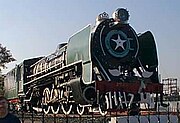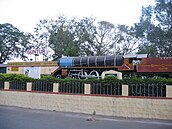User:Venudxb/sandbox/Steam Locomotives of India
Steam[edit]
Nineteenth-century railway companies ordered custom-built locomotives, usually from British manufacturers. The multiplicity of similar-but-not-identical designs increased manufacturing cost and slowed production. During the 1890s, British manufacturers were busy and Indian railway companies looked to Germany and the United States for locomotives.[1] Engines used were:
- Bengal Nagpur Railway:
- Class F: 0-6-0
- Class GM: 2-6-0 (probably modified)
- BNR class HSG: 2-8-0+0-8-2 Garratt, India's first successful Garratts
- Class M: 4-6-2 (probably modified)
- BNR class N: 4-8-0+0-8-4 Garratt, India's largest locomotive. One is preserved at the National Rail Museum, New Delhi
- BNR class NM: Similar to N class; ten were built in 1931 by Beyer Peacock, and it was withdrawn in the late 1960s.
- BNR class P: 4-8-2+2-8-4 Garratt; four were built by Beyer Peacock in 1939. During the early 1970s, they were at the Bhilai (BIA) shed before being withdrawn.
- Bombay, Baroda and Central India Railway:
- East Indian Railway Company:
- Class CT: 0-6-4T, probably converted to a superheater.
- EIR class G: 2-2-2T. First two named Express and Fairy Queen. Built in 1855, the latter is the world's oldest locomotive to be in working order. Later rebuilt by Perambur Loco Works. Housed at East Indian Railway (EIR)
- EIR class P: 4-6-0
- Great Indian Peninsula Railway:
- GIPR classes Y1, Y2, Y3, and Y4: 0-8-4T. Used on Thal Ghat as bankers for pushing trains up the Western Ghats.
- GIPR Class F and F3: 2-6-0
- GIPR class J1: 0-6-0
- Class D4: 4-6-0; one is named Hero.
- Class D5: 4-6-0 passenger locomotive
- Class E1: 4-4-2 Atlantic built by the North British Locomotive Company in 1907–8. Rebuilt with a superheater between 1925 and 1928.
- Class T: Tank locomotive used for hauling Mumbai suburban trains
- Class Y: 2-8-4T
- Crane tank: 0-6-0T; one is preserved at the National Rail Museum in New Delhi.
- Madras and Southern Mahratta Railway:
- Nizam's Guaranteed State Railway:
- NSR class A: 2-6-0T (No. 48, probably an Atlantic) preserved at the National Rail Museum, Delhi.
- North Western State Railway:
- Class EM: 4-4-2 (probably modified); one is preserved at the National Rail Museum [2]
- NWR class GAS: 2-6-2+2-6-2 Garratt; one built in 1925, and retired in 1937.
- NWR class P: 2-4-0
- Class E1: 4-4-2
- Class N1: 4-8-0
- Oudh and Rohilkhand Railway:
- Class B26: 0-6-0; one is preserved at the National Rail Museum.
- Others:
- Class B: 2-6-0
- Class E: 2-4-0
- Class F: 2-8-2, built between 1926 and 1950 by Nasmyth Wilson for service on Central Railway (CR).
- Class G: 2-6-0, probably intended for freight
- Class NA2
- Class PTC: 2-6-4T, owned by Northern Railway (NR); probably a converted passenger locomotive
- Class Y2: 2-8-2T, reclassified L2
- Phoenix: 0-4-0T; one is at the National Rail Museum.
- Ramgotty: 2-2-0T; the National Rail Museum's oldest locomotive, it was converted to broad gauge.
- Sultan, Sahib and Sindh: Hauled the train from VT to Thana in 1853.
Designs[edit]

After acrimonious words in The Times and Parliament, the British Engineering Standards Committee (later the British Engineering Standards Association) began designing a series of locomotives for use by Indian railways. The first two designs emerged in 1903: a 4-4-0 passenger and 0-6-0 goods. They were revised in 1905 and 1906 with additional heavier, more-powerful locomotives:
- Class SP: Standard passenger (4-4-0)
- Class SG: Standard goods (0-6-0)
- Class PT: Passenger tank (2-6-4T)
- Class HP: Heavy passenger (4-6-0)
- Class AP: Atlantic passenger (4-4-2)
- Class HG: Heavy goods (2-8-0)
- Class HT: Heavy tank (2-8-2T)
These advisory BESA designs were customized by the railway companies, which used different classification systems; only the state-operated railways used the class designations SP, SG, PT, HP, AP, HG and HT. When superheating was accepted, superheated versions were classified SPS, SGS and so on (if built with superheaters) and SPC, SGC and so on (if converted from saturated to superheated).
After World War I, larger and more-powerful locomotives were designed by British consulting engineers for the Indian government. They began to appear in 1927:
- Class XA: branch passenger 4-6-2 design, 12.5-ton axle load
- Class XB: light passenger 4-6-2 design, 17-ton axle load
- Class XC: heavy passenger 4-6-2 design, 19.5-ton axle load
- Class XD: Light goods 2-8-2 design, 17-ton axle load
- Class XE: heavy goods 2-8-2 design, 22.5-ton axle load

- Class XF: light shunting 0-8-0 design, 18-ton axle load
- Class XG: heavy shunting 0-8-0 design, 23-ton axle load
- Class XH: 4-cylinder 2-8-2, 28-ton axle load; none were built
- Class XP: experimental passenger 4-6-2, 18.5-ton axle load
- Class XS: experimental 4-cylinder 4-6-2, 21.5-ton axle load
- Class XT: light tank 0-4-2T, 15-ton axle load
During World War II, large numbers of 2-8-2 locomotives were acquired from the United States and Canada and classified AWD and CWD. The Baldwin Locomotive Works adapted the USATC S160 Class locomotive design for India, and it became class AWC. Sixty broad-gauge locomotives were built in 1944 as part of an order of 180 S160 engines. In addition to modified frame spreaders, axles, cylinders, and cab, the Indian locomotives had a turbo generator and electric lighting (not included in the standard European design). Many parts (including boilers) were identical to those in standard-gauge locomotives.[3]
Although new classes were designed shortly before the war, many did not enter service until the post-war period. The new classes were indicated by the change of broad-gauge prefix from X to W, and plans were implemented to begin manufacturing locomotives in India. The new classes were:
- Class WP: passenger 4-6-2, 18.50-ton axle load
- Class WG: goods 2-8-2, 18.50-ton axle load
- Class WL (1st): light 4-6-2, 16.00-ton axle load (four for North Western Railway in 1939; all to Pakistan during partition of India)
- Class WL (2nd): light 4-6-2, 16.75-ton axle load
- Class WM: 2-6-4T, 16.25-ton axle load
- Class WT: 2-8-4T, 18.00-ton axle load
- Class WU: 2-4-2T, 16.50-ton axle load
- Class WV: 2-6-2T, 16.25-ton axle load
- Class WW: 0-6-2T, 16.50-ton axle load
All broad-gauge steam locomotives in India have been withdrawn from normal service, with only occasional steam specials continuing to operate.
Steam[edit]
- Nilgiri Mountain Railway X class
- BESA designs:
- Passenger (4-6-0)
- Mixed (4-6-0)
- Goods (4-8-0)
- Tank (2-6-2T)
- Indian Railway Standards designs of the late 1920s
- Class YA: 4-6-2 with 9-ton axle load (none built)
- Class YB: 4-6-2 with 10-ton axle load (161 built for India and 50 for Burma)
- Class YC: 4-6-2 with 12-ton axle load (15 built for India and 13 for Burma)
- Class YD: 2-8-2 with 10-ton axle load (171 built for India, 61 for Burma, and 25 for East Pakistan)
- Class YE: 2-8-2 with 12-ton axle load (none built)
- Class YF: 0-6-2 with 8-ton axle load; later examples were 2-6-2 (111 built for India)
- Class YK: 2-6-0 version of the 2-6-2 YF, 8-ton axle load (25 built for India)
- Class YT: 0-4-2T with 8-ton axle load (2 built for India)
- Wartime designs:
- Class MAWD: 2-8-2 USATC S118 Class
- Class MWGX: 4-6-2+2-6-4 Garratt
- Indian Railway Standards post war designs
- Class YL: 2-6-2 mixed traffic locomotive with 8-ton axle load (264 built 1953–1957)
- Class YG: 2-8-2 goods locomotive with 10½-ton axle load (1074 built 1949–1972)
- Class YP: 4-6-2 passenger locomotive with 10½-ton axle load (871 built 1952–1968)
- Class YM 2-6-4T with 9-ton axle load (12 built 1956)
Steam[edit]
2 ft 6 in[edit]
- Barsi Light Railway:
- Class A: 0-8-4T
- Class B: 4-8-4T
- Class C: 0-6-0ST
- Class D: 0-4-0
- Class E: Sentinel railcars
- Class F: 2-8-2
- Class G: 4-6-4
- Indian Railway Standards:
- Class ZA: 2-6-2 with 4.5-ton axle load (none built)
- Class ZB: 2-6-2 with 6-ton axle load
- Class ZC: 2-8-2 with 6-ton axle load (none built)
- Class ZD: 4-6-2 with 8-ton axle load (none built)
- Class ZE: 2-8-2 with 8-ton axle load
- Class ZF: 2-6-2T with 8-ton axle load
2 ft[edit]

- Darjeeling Himalayan Railway:
- DHR A Class: 0-4-0WT;
- DHR B Class: 0-4-0ST; #777 and #778 preserved
- DHR C Class: 4-6-2
- DHR D Class: 0-4-0+0-4-0 Garratt
- Indian Railway Standards (none built):
- QA: 2-6-2 with 4.5-ton axle load
- QB: 2-6-2 with 6-ton axle load
- QC: 2-8-2 with 6-ton axle load
- ^ Hughes 1979, p. 17
- ^ "Pakistan Railways steam locomotive | Science Museum Group Collection". collection.sciencemuseumgroup.org.uk. Retrieved 2021-05-26.
- ^ Baldwin Locomotive Works drawing index and bill of materials for special order 43306, locomotive design 2-8-0 19S, numbers 666 to 845 for the U.S. Government, War Department.










